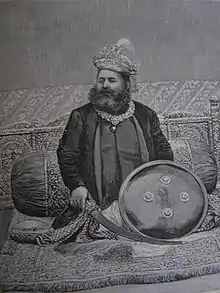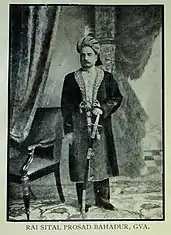The Zamindars of Bihar were the autonomous and semi-autonomous rulers and administrators of the Mughal subah of Bihar and later during British rule. The zamindars of Bihar were numerous and could be divided into small, medium and large depending on how much land they controlled.[1] Within Bihar, the zamindars had both economic and military power. Each zamindari would have their own standing army which was typically composed of their own clansmen.[2]
The majority of these zamindars usually belonged to upper-caste Hindu communities such as Bhumihars, Rajputs, Maithil Brahmins, Kurmis, Kayasthas or Muslims.[3]
The Forward Caste Zamindars also participated in the politics of state of Bihar, and had significant presence in politics in the first few decades of independence. However, since 1970, they started losing this presence and according to DM Diwakar, former Director of AN Sinha Institute of Social Sciences, they were converted into "silent onlookers" by 2020, amidst assertion of Backward Castes and Dalits.[4] Bihar's land reform drive of 1950s led to liquidation of the large landholdings of the big landlords. In the wake of this change, many well to do peasant communities started increasing their landholdings at the cost of big Zamindars. Although, the benefits of these reforms weren't percolated down to the lowest strata of Bihar's society, the Schedule Castes, many new landlords of the post reform period hailed from groups such as Koeri, Kurmi and Yadav caste of Bihar.[5]
Relations with the Mughals
Mughal rule in Bihar was characterised as turbulent and volatile as many of the region's zamindars made continuous efforts to defy the imperial authority.[6]
The nineteenth-century British civil servant, John Beames noted about Mughal-ruled Bihar that "everyone who was powerful enough to rob the state or his neighbours, robbed to his hearts content".[7] Zamindars refusing to pay the state and gathering forces to attack neighbouring zamindars was a common practice in Bihar during this period.[7]
This attitude to authority continued into the period when the Nawabs of Bengal and Murshidabad became the nominal governors of Bihar. Although Bihar had the potential to provide a large amount of revenue and tax, records show that the Nawabs were unable to extract any money from the chiefs of Bihar until 1748. And even following this, the amount gained was very low. This was again due to the rebellious nature of the zamindars who were "continually in arms".[8]
1781 rebellion against the British
After the collapse of the Mughals, the British East India Company held sway over much of South Asia.[9]
Social condition in Zamindari areas
The Permanent Settlement act by the British East India Company did not significantly alter the landholding patterns in Bihar, leaving Rajputs and Bhumihars as the major Zamindars. It curtailed some of their powers, but also took away the customary occupancy rights of the peasantry.[10] The British rule enabled Rajputs to continue their dominance by cementing their entitlements related to land and tax collection.[11] Exercise of coercive power by the dominant castes[12] over the vulnerable landless labourers took various forms such as forced labour, higher rents, lower wages, social restrictions, evictions and sexual harassment.[10]: 75 Rape of women from lower caste by Rajput and Bhumihar landowners was common in the Shahabad district,[10] particularly in couple of villages of Bhojpur (modern name for Shahabad district), where sexual desire of the upper-castes was satisfied through arrogant and unrestricted access to the modesty of women belonging to Chamar and Musahar caste.[13][14] Emerging organizations of middle peasant castes like Triveni Sangh[10] and Kisan Sabhas took up the issues of exploitation,[15] with the Naxal threat also acting as a check.[13]
Abolition and decline in political presence of Zamindars

Following independence in 1947, there was large-scale support in Bihar for the abolition of zamindari especially among peasants, agricultural labourers and the urban middle-class who stood to gain the most from this.[16] This culminated in a large-scale movement in support of abolition led by lower-castes. The Bhumihar zamindars realised that abolition was going to occur and planned for abolition to be on their terms.[16] However, the Rajput-Kayastha zamindars strongly resisted this. Eventually, the Bihar Abolition of Zamindaris Act was passed in 1949.[16]
In the later period of time, when the abolition of Zamindari took place in Bihar and the castes like Yadav, Kurmi, Koiri and Bhumihar became the prime movers of the emerging capitalist agriculture system of central Bihar. The new semi-feudal social order brought unintended benefits for these caste groups in which the question of dignity and minimum wages came to the fore. The Green Revolution further benefited these communities.[17] Hence, in later periods, many landed Other Backward Castes also emerged as zamindars, primarily from a group called Upper Backward Castes.[18]
Prior to the independence of India, many forward caste Zamindars started taking interest in politics, and they also participated in the Quit India Movement, anticipating the end of British rule, which protected them. According to DM Diwakar, a former director of Patna’s AN Sinha Institute of Social Sciences, these feudal elites had significant presence in politics of the state in first few decades of the post-independence period, but they started losing this significant position in 1970s. In the first tenure of Nitish Kumar, they staged a comeback in the politics of state, but in the next tenures, they were completely marginalised and according to Diwakar, were converted into "silent onlookers" by 2020.[4]
Notable zamindari estates
See also
References
- ↑ Lata Singh (2012). Popular Translations of Nationalism: Bihar, 1920-1922. Primus Books. pp. 5–7. ISBN 978-93-80607-13-9.
- ↑ Tahir Hussain Ansari (20 June 2019). Mughal Administration and the Zamindars of Bihar. Taylor & Francis. p. 2. ISBN 978-1-00-065152-2.
- ↑ Jha, Hetukar (1 October 1977). "Lower-Caste Peasants and Upper-Caste Zamindars in Bihar (1921-1925): An Analysis of Sanskritization and Contradiction between the Two Groups". The Indian Economic and Social History Review. 14 (4): 549–559. doi:10.1177/001946467701400404. S2CID 143558861. Retrieved 28 March 2019.
- 1 2 "Bihar Assembly Election 2020: Royal, zamindar families remain a marginal force". Hindustan Times. Archived from the original on 10 July 2022. Retrieved 10 July 2022.
- ↑ Chetan Choithani (2023). Migration, Food Security and Development: Insights from Rural India. Cambridge University Press. p. 107. ISBN 978-1009276771. Archived from the original on 29 August 2023. Retrieved 18 August 2023.
Although the end of zamindari led to a mass eviction of sharecroppers and tenant cultivators who were the actual tillers of the land, big landlords from high castes also saw their landholdings diminish. A new class of landlords belonging to the upper-middle caste groups such as Kurmi, Koeri and Yadavs- officially categorised as other backward classes in contemporary Bihar - emerged. These were mostly small and middle peasants who were able to consolidate their landholdings and position in society in the midst of zamindari reforms (Wilson, 1999; Sharma, 2005).
- ↑ Kumkum Chatterjee (1996). Merchants, Politics, and Society in Early Modern India: Bihar, 1733-1820. BRILL. pp. 31–32. ISBN 90-04-10303-1.
- 1 2 Gyan Prakash (30 October 2003). Bonded Histories: Genealogies of Labor Servitude in Colonial India. Cambridge University Press. pp. 88–90. ISBN 978-0-521-52658-6.
- ↑ P. J. Marshall (2 November 2006). Bengal: The British Bridgehead: Eastern India 1740-1828. Cambridge University Press. pp. 58–60. ISBN 978-0-521-02822-6.
- ↑ P. J. Marshall (2 November 2006). Bengal: The British Bridgehead: Eastern India 1740-1828. Cambridge University Press. pp. 95–. ISBN 978-0-521-02822-6.
- 1 2 3 4 Vinita Damodaran (1992). Broken Promises: Popular Protest, Indian Nationalism, and the Congress Party in Bihar, 1935-1946. Oxford University Press. p. 75. ISBN 978-0-19-562979-8.
The rape of lower-caste women by Rajput and Bhumihar landowners was common in Shahabad where , by the 1930s , anger and resentment against the frequent violation of women were openly expressed on the platform of the Tribeni Sangh
- ↑ Jaffrelot, Christophe (2000). "The Rise of the Other Backward Classes in the Hindi Belt". The Journal of Asian Studies. 59 (1): 86–108. doi:10.2307/2658585. ISSN 0021-9118. JSTOR 2658585. S2CID 162845558.
But the upper castes remained politically dominant in the Hindi belt also because of the pattern of land ownership that enabled them, especially the Rajputs, to consolidate their grasp over the countryside as zamindars, jagirdars, or taluqdars under the British and to retain some of their influence in spite of the efforts toward land reform after 1947.
- ↑ Bailey, F. G. (1960). Tribe Caste and Nation (1960). Oxford University Press. p. 258.
The system works the way it does because the coercive sanctions are all in the hands of the dominant caste.
- 1 2 Kaushal Kishore Sharma; Prabhakar Prasad Singh; Ranjan Kumar (1994). Peasant Struggles in Bihar, 1831-1992: Spontaneity to Organisation. Centre for Peasant Studies. p. 247. ISBN 9788185078885.
According to them, before the emergence of Naxalism on the scene and consequent resistance on the part of these hapless fellows, "rape of lower caste women by Rajput and Bhumihar landlords used to cause so much anguish among the lower cates, who, owing to their hapless situation, could not dare oppose them. In their own words, "within the social constraints , the suppressed sexual hunger of the predominant castes often found unrestricted outlet among the poor, lower caste of Bhojpur-notably Chamars and Mushars.
- ↑ Fernando Franco (2002). Pain and Awakening: The Dynamics of Dalit Identity in Bihar, Gujarat and Uttar Pradesh. Indian Social Institute. p. 52. ISBN 9788187218463.
Even as late as the 1970s , the rape of lower caste women by Rajputs and Bhumihars had almost become a tradition , " an accepted social evil , a fate which many bore unquestioningly " , in parts of central Bihar
- ↑ Kelkar, Govind (1989). "Women and Land Rights Movements". Case Studies on Strengthening Co-ordination Between Non-governmental Organizations and Government Agencies in Promoting Social Development. United Nations (Economic and Social Commission for Asia and the Pacific). Sec. "Kisan Sabha and Kisan Samiti: Peasant Movemnts and Women (India)", pp. 72–73.
- 1 2 3 Mitra Subrata K; Bhattacharyya Harihar (27 February 2018). Politics And Governance In Indian States: Bihar, West Bengal And Tripura. World Scientific Publishing Company. pp. 155–158. ISBN 978-981-320-824-7.
- ↑ Kumar, Ashwani (2008). Community Warriors: State, Peasants and Caste Armies in Bihar. Anthem Press. p. 94. ISBN 978-1-84331-709-8.
- ↑ The National Geographical Journal of India. National Geographical Society of India. 1975.





